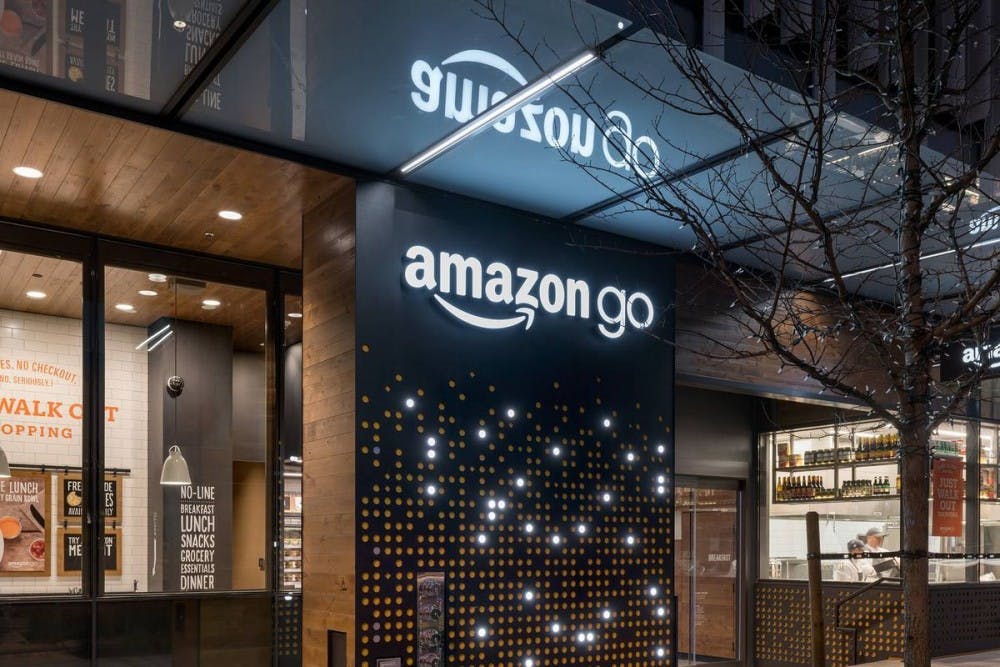Back in my day, walking into a store, grabbing food, and walking straight out without paying at a cash register was considered “stealing.” However, in the modern world of 2018, this action will now be considered “technology-assisted consumerism,” or something else that Silicon Valley marketers come up with.
On Monday, January 22nd, Amazon officially opened their first physical store location in Seattle, named Amazon Go. This brick-and-mortar grocery store will do away with traditional cashiers and baggers, offering shoppers to instead take what they need to buy and leave, automatically being charged as they walk out of the store. The only requirement is that customers download the Amazon Go app and scan it at one of the turnstile-like kiosks as they enter the store. Smart devices throughout the store like cameras and sensors keep track of who is buying what, then all the items a customer purchases will automatically be charged to their Amazon account as they leave the store with groceries. This allows consumers to avoid waiting in long checkout lines and enables Amazon to compete in the one retail market they were lacking: food.
The technology is still in the testing phase, and often runs into difficulty accounting for human error, like most technology. Instances where hoards of people checkout at the same time, people putting back items in the wrong shelf space, and people generally just being problematic has hindered the store’s release, which was originally announced in December 2016 and planned to open early 2017. Now, a year later, the store has become a reality.
The Amazon Go marketplace is just the most prominent tale of Silicon Valley looking to redefine the traditional brick-and-mortar landscape. With companies like Amazon allowing consumers to shop for virtually everything without even leaving the bedroom, traditional store outlets such as Sears, Macy’s, and Best Buy have either needed to upgrade to the Internet or die trying. Hundreds of old-fashioned stores have been closing across the nation in the last few years, unable to keep up with the likes of Silicon Valley. Amazon, which started out selling books online in the 1990’s, now has their own bookstores to compete with Barnes & Noble and… well, I guess just Barnes & Noble. That, in addition to their buyout of Whole Foods last summer and the opening of the Amazon Go store, Amazon is quite literally giving old-fashioned stores a run for their money. With so many retail spaces being made available, it’s no wonder Silicon Valley has decided to sink its teeth into the physical marketplace even further.

Image from The Verge
In order to compete for storefront attention, Apple has announced their new “Town Square” store model that may end up replacing the traditional Apple Stores. The first of these new storefronts opened in October of last year in Chicago, combining the typical product selling of an Apple Store with new community resources, such as conference rooms, classes for coding and other experience-driven opportunities, and green spaces to entice the community-focused Millennial generation that has “killed brick and mortar,” according to multiple online articles. So, imagine a Starbucks, but with even less coffee and triple the amount of Apple products, where you still pay way too much for what you buy.
Google isn’t one to be left out, although their strategy is a bit different and even confusing, as they always seem to be. Google apparently prefers to open pop-up stores around the country in order to promote their latest products, such as the Pixel line of phones and their smart home devices, but they have yet to create a permanent and concrete – or, should I say, brick-and-mortar – storefront to sell products through. But, I’m sure once Amazon and Apple popularize it, Google will eventually catch up.
All this being said, I can only imagine a day in the near future where I drive in my Google driverless car to the Amazon Go or Whole Foods, pick up my gluten-free, dairy-free, GMO-free kale burgers, walk right out, drive over to the Apple Town Square to see people buying the iPhone Z, laugh at them, then charge up my electric self-driving car and pay for it using AndroidPay. That is Silicon Valley’s oligopolistic dreamscape right there, and it could be a reality sooner than we might think.
Sources: The Washington Post, The New York Times, Forbes, LinkedIn, Twice, Byte
Images: Business Insider, The Verge



















